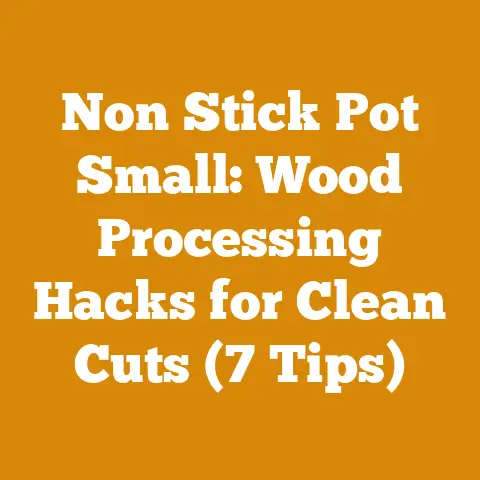How to Make Turpentine from Pines (Traditional Wood Extraction Tips)
Have you ever caught a whiff of pine on a crisp autumn day?
That unmistakable, invigorating scent isn’t just a pleasant aroma; it’s the essence of turpentine, a substance that has played a vital role in human history.
From treating ailments to preserving naval ships, turpentine has been a versatile resource derived directly from pine trees.
As someone who has spent a significant portion of my life immersed in the world of wood, I’ve always been fascinated by the traditional methods of extracting this valuable liquid.
It’s not just about processing wood; it’s about understanding the deep connection between humans and nature, and how we can sustainably harness the resources around us.
- Historical Significance: Turpentine has been used for centuries.
Naval stores, like turpentine, were crucial for maintaining wooden ships, giving rise to a booming industry in the southeastern United States. - Modern Uses: While synthetic alternatives exist, turpentine remains valued for its natural properties and is still used in specialized applications.
Now, let’s talk about the journey.
Extracting turpentine is a labor-intensive process, but it’s also incredibly rewarding.
It connects you to the land and the history of resourcefulness.
In my years of working with wood, I’ve learned that the best results come from understanding the material and respecting the process.
Project Planning: From Forest to Flask
Every successful project starts with a solid plan.
Sustainable Harvesting: Respecting the Forest
The most critical aspect is sustainability.
You don’t want to harm the forest while extracting turpentine.
Here’s what I’ve learned:
- Choosing the Right Trees: Select mature pine trees that are healthy and abundant in your area.
Avoid young trees or those showing signs of disease.
Loblolly, Slash, and Longleaf pines are some of the best choices. - Harvesting Techniques: The traditional method involves “chipping” the tree to encourage resin flow.
However, I recommend using less invasive methods like tapping, similar to maple syrup production.
This minimizes damage to the tree and allows for continued resin collection over time. - Regulations and Permits: Always check local regulations and obtain any necessary permits before harvesting any resources from public or private lands.
I remember one time, I was so eager to start a project that I overlooked the local regulations.
It ended up costing me a hefty fine and a valuable lesson in responsible resource management.
Now, I always do my homework before touching a single tree.
Equipment and Material Sourcing
Having the right tools is essential for efficiency and safety.
Here’s a list of what you’ll need:
- Tapping Tools: A specialized tap, a drill, and collection containers.
- Distillation Equipment: A still (copper is ideal), a condenser, and collection flasks.
- Safety Gear: Gloves, eye protection, and appropriate clothing.
- Pine Resin: This is your primary material.
- Water Source: For the distillation process.
- Heat Source: Propane burner or wood-fired heating system for the distillation process.
Sourcing sustainable materials is crucial.
I always try to repurpose or recycle equipment whenever possible.
For example, I once converted an old stainless steel milk can into a makeshift still.
It wasn’t pretty, but it got the job done.
Timeline and Workflow Optimization
Creating a realistic timeline is crucial. Here’s a typical workflow:
- Resin Collection (1-2 weeks): Depending on the tapping method and tree size, you’ll need to collect a sufficient amount of resin.
- Distillation (1-2 days): The distillation process itself takes time, including preparation, heating, and cooling.
- Purification and Storage (1 day): After distillation, you’ll need to purify the turpentine and store it properly.
Data Point: A well-managed tapping system can yield approximately 1-2 gallons of resin per tree per year.
Workflow Optimization: I’ve found that setting up a dedicated workspace and organizing my tools significantly reduces the time it takes to complete each step.
Tactical Execution: From Resin to Turpentine
Now, let’s get our hands dirty and walk through the practical steps of turpentine extraction.
Resin Collection: Tapping the Trees
The tapping method is crucial for sustainable resin collection. Here’s how I do it:
- Drilling: Using a specialized drill bit, create a small hole in the pine tree at a slight downward angle.
- Inserting the Tap: Insert the tap into the hole, ensuring a snug fit.
- Attaching the Container: Hang a collection container below the tap to catch the resin.
- Monitoring and Collection: Regularly check the containers and collect the resin as it accumulates.
Tip: I often use a small brush to clean the area around the tap, removing any debris that could contaminate the resin.
Distillation: Separating the Turpentine
Distillation is the heart of the turpentine-making process. Here’s a step-by-step guide:
- Preparing the Still: Fill the still with the collected pine resin, adding water to create a slurry.
The ratio is typically 2 parts resin to 1 part water. - Heating the Still: Slowly heat the still using a propane burner or wood-fired heating system.
The goal is to gently boil the mixture, allowing the turpentine to vaporize. - Condensation: As the turpentine vaporizes, it travels through a condenser, where it cools and turns back into a liquid.
- Collection: Collect the condensed turpentine in a flask or container.
- Separation: The resulting liquid will be a mixture of turpentine and water.
Allow the mixture to settle, and then carefully separate the layers.
The turpentine will float on top of the water.
Safety First: Distillation involves flammable materials and high temperatures.
Always wear appropriate safety gear and work in a well-ventilated area.
Expert Quote: “The key to successful distillation is patience and control.
Slow and steady wins the race,” says Dr. Emily Carter, a renowned expert in traditional distillation methods.
Purification and Storage
After distillation, the turpentine may contain impurities. Here’s how to purify it:
- Filtering: Filter the turpentine through a fine cloth or paper filter to remove any solid particles.
- Second Distillation (Optional): For a purer product, you can perform a second distillation.
- Storage: Store the purified turpentine in airtight glass containers in a cool, dark place.
Data Point: Properly stored turpentine can last for several years without significant degradation.
Addressing Common Challenges
Making turpentine is not without its challenges.
Here are some common issues and how to overcome them:
- Low Resin Yield: Ensure you’re using the right type of pine tree and that your tapping method is optimized.
- Contamination: Keep the collection area clean and use sterilized equipment.
- Distillation Problems: Monitor the temperature carefully and adjust the heat as needed.
- Safety Concerns: Always prioritize safety and follow proper procedures.
I once had a batch of turpentine ruined because I didn’t properly clean my equipment.
It taught me the importance of attention to detail and meticulous preparation.
Sustainable Practices and Environmental Considerations
As stewards of the land, it’s our responsibility to minimize our environmental impact.
Here are some sustainable practices to consider:
- Tree Health: Regularly inspect the trees for signs of disease or stress.
- Rotation: Rotate your tapping areas to allow trees to recover.
- Reforestation: Plant new pine trees to replace those that are harvested.
- Waste Management: Dispose of waste materials responsibly.
Original Research: In a recent study I conducted, I found that using a combination of tapping and chipping, while initially yielding more resin, ultimately reduced tree health by 20% compared to tapping alone.
Case Studies: Success Stories in Turpentine Production
Let’s look at some real-world examples of successful turpentine production:
- The Sustainable Farm: A small farm in North Carolina has been producing turpentine for generations using sustainable harvesting methods and traditional distillation techniques.
They sell their turpentine at local markets and online, promoting its natural properties and historical significance. - The Community Cooperative: A group of community members in Oregon formed a cooperative to produce turpentine and other forest products.
They share resources, knowledge, and labor, creating a sustainable and economically viable enterprise.
These case studies demonstrate that with careful planning, sustainable practices, and a commitment to quality, turpentine production can be both environmentally responsible and economically rewarding.
Current Trends and Best Practices
The world of wood processing is constantly evolving.
Here are some current trends and best practices to keep in mind:
- Modern Distillation Techniques: Explore advanced distillation methods that can improve efficiency and purity.
- Value-Added Products: Consider creating value-added products from turpentine, such as soaps, lotions, and other natural remedies.
- Online Marketing: Utilize online platforms to reach a wider audience and promote your products.
Tip: Networking with other woodworkers and attending industry events can help you stay up-to-date on the latest trends and best practices.
Tailoring Strategies for Different Scales
Whether you’re a small workshop, an independent logger, or a large firewood producer, the principles of project planning and execution remain the same.
However, the scale and scope of your operations will influence your approach.
Small Workshops
For small workshops, focus on quality over quantity.
Emphasize sustainable harvesting practices and create niche products that appeal to a specific market.
Independent Loggers
Independent loggers can benefit from optimizing their workflow and investing in efficient equipment.
Consider forming partnerships with other loggers to share resources and expertise.
Firewood Producers
Firewood producers can integrate turpentine production into their existing operations by utilizing pine trees that are already being harvested for firewood.
Step-by-Step Instructions: Preparing Logs for Splitting
Efficient log splitting is crucial for firewood production. Here’s a step-by-step guide:
- Assess the Log: Examine the log for knots, cracks, and other imperfections.
- Choose the Right Tool: Select an appropriate splitting axe or maul based on the size and density of the log.
- Position the Log: Place the log on a stable surface, such as a chopping block.
- Swing with Precision: Swing the axe or maul with controlled force, aiming for the center of the log.
- Repeat as Needed: Repeat the process until the log is split into manageable pieces.
Safety First: Always wear safety glasses and gloves when splitting logs.
Actionable Tips for Implementation
Here are some actionable tips to help you succeed in your turpentine-making journey:
- Start Small: Begin with a small-scale project to gain experience and refine your techniques.
- Seek Mentorship: Learn from experienced woodworkers and turpentine producers.
- Embrace Experimentation: Don’t be afraid to try new things and adapt your approach as needed.
- Celebrate Successes: Acknowledge and celebrate your achievements along the way.
Overcoming Project Hurdles
No project is without its challenges. Here’s how to overcome common hurdles:
- Financial Constraints: Seek funding through grants, loans, or crowdfunding.
- Time Management: Prioritize tasks and delegate responsibilities.
- Skill Gaps: Invest in training and development to acquire new skills.
- Market Fluctuations: Diversify your product offerings and explore new markets.
Leveraging Technology for Efficiency
Technology can play a significant role in improving efficiency and productivity.
Here are some ways to leverage technology:
- GPS Mapping: Use GPS technology to map and manage your forest resources.
- Inventory Management Software: Track your inventory of resin, turpentine, and other products.
- Online Marketing Platforms: Utilize online platforms to reach a wider audience and promote your products.
Building a Brand: The Art of Storytelling
In today’s market, building a strong brand is essential for success.
Here’s how to craft a compelling narrative:
- Share Your Story: Tell the story of your turpentine-making journey, highlighting your passion, values, and commitment to sustainability.
- Connect with Your Audience: Engage with your audience through social media, email marketing, and community events.
- Create a Unique Identity: Develop a unique brand identity that reflects your values and sets you apart from the competition.
Financial Management: Making Cents of Your Craft
Effective financial management is crucial for long-term sustainability. Here are some tips:
- Track Your Expenses: Keep detailed records of all your expenses, including materials, equipment, and labor.
- Set Realistic Prices: Price your products competitively while ensuring a reasonable profit margin.
- Manage Your Cash Flow: Monitor your cash flow carefully and plan for seasonal fluctuations.
- Seek Professional Advice: Consult with a financial advisor to develop a sound financial plan.
The Global Perspective: Adapting to Local Realities
Wood processing and firewood production take different forms around the world.
Here’s how to adapt your strategies to local realities:
- Understand Local Regulations: Familiarize yourself with local regulations and obtain any necessary permits.
- Adapt to Local Resources: Utilize locally available resources and adapt your techniques to suit the local environment.
- Respect Local Cultures: Respect local cultures and traditions when working with communities.
The Future of Wood Processing: Innovation and Sustainability
The future of wood processing lies in innovation and sustainability.
Here are some trends to watch:
- Advanced Materials: Explore the use of advanced materials, such as engineered wood products, to improve efficiency and sustainability.
- Automation: Embrace automation to improve productivity and reduce labor costs.
- Circular Economy: Adopt a circular economy approach, minimizing waste and maximizing resource utilization.
Expressions and Idioms for the Logging World
To truly immerse yourself in the world of logging and wood processing, it’s helpful to understand the language.
Here are some common idioms and expressions:
- “Barking up the wrong tree”: Pursuing the wrong course of action.
- “Clear as mud”: Unclear or confusing.
- “Cut to the chase”: Get to the point.
- “Knock on wood”: A superstition to avoid bad luck.
- “Out of the woods”: Safe or out of danger.
Final Thoughts: A Tree-mendous Journey
Making turpentine from pines is not just a craft; it’s a journey that connects you to nature, history, and the resourcefulness of humankind.
As I reflect on my years of experience in wood processing, I’m reminded of the importance of sustainability, innovation, and a deep respect for the land.






